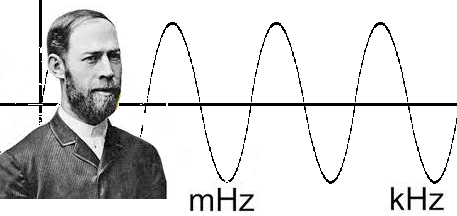

“Day by day I grow more aware of how useless I remain in this world,” said a young Heinrich Hertz whose birthday we celebrate today. Well, Hertz proved he wasn’t useless by bringing us the unit of frequency we rely on for communication, the “Hertz.”

Heinrich Hertz, the oldest of five children, was born on February 22, 1857 in Hamburg Germany to the daughter of a physician and a father who was an attorney turned senator.
Hertz expressed his interest in math and science at an early age when he told his parents that he wanted to be an engineer, at which point, they enrolled him in a private school that focused on the sciences.
When Hertz was 15, he left his school to be home schooled. However, he quickly decided that he wanted to go back to university and consequently needed to study Greek and Latin to prepare for the entry exams. It was around that time that one of Hertz’s tutors, seeing his natural talent for language acquisition, suggested that Hertz study oriental languages.
However, Hertz found himself drawn in another direction. With the help of an additional private tutor, Hertz began studying science and math again and in the evenings, he would spend his time constructing models and sophisticated scientific apparatuses. One such instrument was a spectroscope, which he used to conduct his own experiments.
Two years later, Hertz went back to school where he switched from studying language to becoming an architect’s apprentice. By day he would work and at night he read physics books. It didn’t take long before Hertz grew bored of architecture and once again switched career paths.
At age 19, Hertz moved to Dresden to study engineering, but that didn’t last. Just a few months later, Hertz was drafted into the army for one year, which he found to be miserably boring.
Hertz’s interest in math and physics was increasing and at age 21, he enrolled at the University of Berlin to study physics. It was in Berlin that Hertz was asked to solve a problem: Does electric current have mass? After a year of hard work, Hertz successfully demonstrated that if a current has any mass then it must be small.
Hertz soon began to gain recognition for his work and was asked to solve another puzzle: verify James Clerk Maxwell’s theory of electromagnetism. Hertz declined the project and instead worked on electromagnetic induction, which led to a job as an assistant professor.
In March 1885 at age 28, Hertz accepted a professorship at the University of Karlsruhe because of its outstanding lab facilities. Hertz, wondering what to research next, chose to take on proving Maxwell’s theory. After several months, Hertz discovered that sparks were producing an electrical vibration within the wires that they jumped between. If Maxwell’s theory was right, these electric charges would radiate electromagnetic waves, passing through air in the same way light does.
One year later, Hertz created an oscillator – two hollow zinc spheres, connected to copper wires, with a gap in the middle for sparks to jump between. Hertz applied high voltage electricity across the gap, thus, creating sparks. The sparks caused pulses of electric current within the copper wires, the pulses reverberated back and forth at a rate of 100 million per second, proving what Maxwell had predicted, the oscillating electric charges created electromagnetic waves, also known as, radio waves.
Over the next three years Hertz proved that radio waves and light waves are part of the same family, the electromagnetic spectrum.
Ironically, Hertz said, “I do not think that the wireless waves I have discovered will have any practical application…” he was dead wrong in that regard. These waves changed the world.
Hertz’s discovery of radio waves paved the way for modern communication technologies, including radio, television, satellite communications and of course, mobile phones. We even use electromagnetic waves to heat our food in microwave ovens.
However, Hertz wasn’t done yet…
In 1887, Hertz reported a phenomenon we know as the photoelectric effect. He wrote about the effect, but left others to pursue it, which led Albert Einstein to rethink the theory of light.
At age 29, Hertz married an influential biologist and they had two daughters. Seven years later at age 36, Hertz died of blood-vessel inflammation from immune system problems. In 1930 the unit of frequency was named the hertz and was made official in 1960.
Despite having a tragically short life, Hertz accomplished more than some people accomplish in a lifetime. He brought us the technology that enabled the devices many of us take for granted.
We owe much to Heinrich Hertz. So when you talk about MHz this or GHz that, be sure to raise a glass to the man who started it all.


